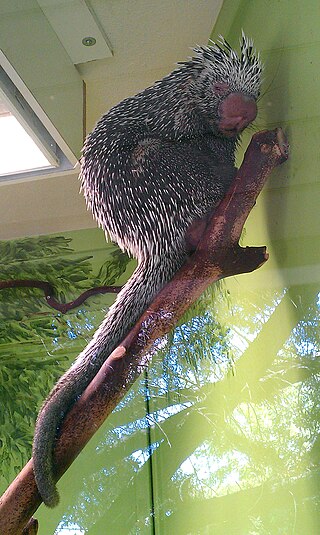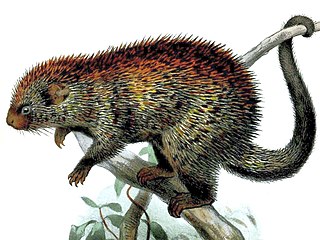Gymnures, also called hairy hedgehogs or moonrats, are mammals belonging to the subfamily Galericinae, in the family Erinaceidae and the order Eulipotyphla. Gymnures resemble rats but are not closely related as they are not rodents; they are instead closely related to hedgehogs, which also belong to Erinaceidae. They are thought to have appeared in Eastern Asia before their closest relatives, and changed little from the original ancestor, which is thought to have been also the ancestor of the shrews.

Erinaceidae is a family in the order Eulipotyphla, consisting of the hedgehogs and moonrats. Until recently, it was assigned to the order Erinaceomorpha, which has been subsumed with the paraphyletic Soricomorpha into Eulipotyphla. Eulipotyphla has been shown to be monophyletic; Soricomorpha is paraphyletic because Soricidae shared a more recent common ancestor with Erinaceidae than with other soricomorphs.

The prehensile-tailed porcupines or coendous are found in Central and South America. Two other formerly recognized Neotropical tree porcupine genera, Echinoprocta and Sphiggurus, have been subsumed into Coendou, since Sphiggurus was shown by genetic studies to be polyphyletic, while Echinoprocta nested within Coendou.

The Javan short-tailed gymnure is a small mammal from the family of the Erinaceidae. The scientific name of the species is first published by Salomon Müller in 1840. This species used to include the dorsalis, maxi, and peguensis subspecies, but these have now been elevated to species of their own: the Bornean short-tailed gymnure, Max's short-tailed gymnure, and the northern short-tailed gymnure. In addition, two new species were created from two other populations of H. suillus. The range of this species is now limited to Java.

The dwarf gymnure is a gymnure found only at Mount Kerinci, Sumatra, Indonesia. It is listed by the International Union for Conservation of Nature as a critically endangered species due to a restricted range.

The Paraguaian hairy dwarf porcupine is a porcupine species from the family Erethizontidae. It is found in Argentina, Brazil, Paraguay and Uruguay.
Brachyuromys is a genus of rodent in the family Nesomyidae. It contains the following species:

The Indomalayan pencil-tailed tree mouse or simply pencil-tailed tree mouse is a species of arboreal rodent in the family Muridae. It is found in northeastern India, southern China, Myanmar, Thailand, Laos, Cambodia, Vietnam, Peninsular Malaysia, and Indonesia. This locally abundant but patchily distributed species occurs in primary and secondary forests, without affinity to particular forest types. It can suffer from deforestation and is sometimes harvested for consumption.
Geoxus is a genus of South American rodents in the tribe Abrotrichini of family Cricetidae. Two species—Geoxus valdivianus and Geoxus annectens are known.

Edwards's long-tailed giant rat is a species of rodent in the family Muridae. It is found in China, India, Indonesia, Laos, Malaysia, Burma, Thailand, and Vietnam.

Nesokia is a genus of rodent in the family Muridae endemic to West Asia and Central Asia known as the short-tailed bandicoot rats.

Taphozous is a genus of the family Emballonuridae. The wide distribution of the genus includes several regions of Australia, Indonesia, Papua New Guinea and Africa. Taphozous comes from the Greek τάφος, meaning "a tomb". The common names for species include variants on sac-winged, sheathtail, or tomb bats.
Dendrogale is a genus of treeshrew in the family Tupaiidae found in Southeast Asia and Borneo. It contains these species:
Podogymnura is a genus of mammal in the family Erinaceidae. It contains the following species:
Blarinella is a small genus of shrews in the subfamily Soricinae of the family Soricidae. It contains the following three species:

African free-tailed bats (Myopterus) are a genus of bat in the family Molossidae. It contains the following species:

The Indochinese short-tailed shrew is a species of mammal of the family Soricidae found in China and Vietnam. The species is a semifossorial red-toothed shrew with a stout body and short, slender tail. Blarinella is distinguished from all other Southeast Asian shrew genera by their long claws, intensive colored red-tipped teeth, and five upper unicuspids. Although this species is classified under Blarinella, recent Cytochrome b analysis suggests this species should be classified under a new genus.

Megaderma is a genus of bat in the family Megadermatidae. It contains two living species:

The long-eared gymnure is a eulipotyphlan that is found in Laos. This specific type of gymnure has long ears and a long skull compared to that of others. It is also recognized for its broad forefeet, stout claws, and naked hindfeet. While it was previously lumped in with the dwarf and short-tailed gymnures of the genus Hylomys, it is now placed in its own genus Otohylomys.













